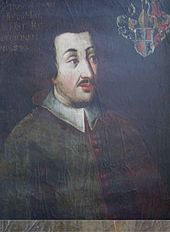Beatus a Porta
Beatus a Porta (* 1530 in Davos , † 1590 in Riffian ) was a Roman Catholic bishop of the diocese of Chur .
Life
The son of a Landammann (mayor) in the ten-court federation studied in Freiburg im Breisgau in Orléans and Paris , was pastor in Feldkirch in 1562 and became canon in Chur .
The Bündner Land existed since the 14./15. Century to 1798 from three sub-states (Bünden): the church federation in Chur with eleven high courts , the upper or gray federation ( Graubünden ) in Disentis with eight and the ten court federation in Davos with seven high courts.
Beatus a Porta, in possession of the citizenship of Chur , was elected on May 26, 1565 to succeed Thomas Planta as the new bishop of Chur. After the announcement of the election, there was unrest under the influence of the Church of God and the proclamation of an opposing bishop in the person of Bartholomew Hieronymus von Salis, who was defeated for the third time . Both parties turned to the Emperor and Pope for support for their candidates. On August 24, 1565, Pope Pius IV confirmed the legitimately elected Beatus a Porta as Bishop of Chur. The Archbishop of Naxos Francesco Pisani gave him on 21 November 1565 Rome the episcopal ordination ; Co- consecrators were Andrea Matteo Acquaviva d'Aragona , the Archbishop of Cosenza and Ascanio Albertini , the Bishop of Avellino-Frigento .
Von Salis did not accept the defeat. While Beatus a Porta was in Rome for consecration, he plundered the prince-bishop's palace, set it on fire and partially destroyed it.
On February 10, 1566, Bishop Beatus a Porta received imperial regalia from Emperor Maximilian II . On June 4th of the same year the city of Chur, the Obere / Graue Bund and the Ten-Judgment Federation paid homage to him. The Church of God continued to adhere to Salis and refused to pay homage to the new bishop. On June 28, 1566, Salis resigned and left the prince-bishop's palace at the end of the year; In 1570 he renounced his canonical in Chur and died that same year in Albosaggia in Valtellina .
Bishop Beatus a Porta, who sought refuge at the Fürstenburg , returned to Chur on January 2, 1567, but did not succeed in gaining the trust of the Church of God. Again and again there were disputes, so that he was forced to withdraw to his refuge in Vinschgau in 1575. He refused to return to his diocese of Chur and appointed in 1576 provost and vicar general Nicolaus Venosta as his deputy in Chur. The church federation occupied important offices, the bishop was withdrawn from secular power and his income blocked. On February 25, 1580 Beatus a Porta announced his resignation under pressure from the papal envoy Giovanni Francesco Bonhomini . His resignation became final when a pension contract was issued on June 4, 1581, which guaranteed him an annual pension of 400 guilders. He retired to a private house in his already 1576 on the presentation of Archduke Ferdinand of Austria by Pope Gregory XIII. (1572–1585) granted the parish of St. John the Baptist back to Tyrol, which also included the city of Meran .
Beatus a Porta died in 1590 near Meran and was buried in the parish church of Our Lady of Sorrows (Riffian) .
literature
- Pierre Surchat: Porta, Beatus a. In: Historical Lexicon of Switzerland .
- Erwin Gatz : The Bishops of the Holy Roman Empire. 1448 to 1648. Duncker and Humblot, Berlin 1996, ISBN 3-428-08422-5 , pp. 549 f.
- Albert Fischer: Reformatio and Restitutio: The Diocese of Chur in the Age of Tridentine Faith Renewal. At the same time a contribution to the history of priestly formation and pastoral reform (1601–1661). Chronos, Zurich 2000, ISBN 3-905314-14-2 , pp. 148–155.
Web links
- Entry on Beatus di Porta on catholic-hierarchy.org ; accessed on November 14, 2016.
- The portraits of the Chur (prince) bishops in the knight's hall of the Episcopal Palace in Chur - Beat à Porta 1565–1581 ( Memento from November 11, 2013 in the Internet Archive )
Individual evidence
- ↑ Hierarchia Catholica Medii et Recentioris Aevi. Volume 3, p. 183
- ↑ Sacres Episcopaux a Rome de 1565 a 1662. P. 7, No. 4
- ^ Albert Fischer: Beat à Porta 1565–1581.
| predecessor | Office | successor |
|---|---|---|
| Thomas Planta |
Bishop of Chur 1565–1581 |
Peter Rascher |
| personal data | |
|---|---|
| SURNAME | Porta, Beatus a |
| ALTERNATIVE NAMES | Porta, beat à; Porta, Beatus di |
| BRIEF DESCRIPTION | Bishop of Chur |
| DATE OF BIRTH | 1530 |
| PLACE OF BIRTH | Davos |
| DATE OF DEATH | 1590 |
| Place of death | Riffian |

